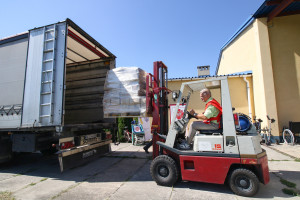They will attack in swarms. This is all due to the heavy rainfall.

Heavy rainfall and temperatures exceeding 20 degrees Celsius are – as Professor Myczko from the Department of Zoology at the University of Social Sciences and Humanities said in an interview with PAP – ideal conditions for the appearance of numerous mosquitoes and increased tick activity .
"There are mosquito species that, as imagos (adults - PAP note), can survive periods of drought and low temperatures, waiting for conditions to improve. Others remain in egg form until heavy rainfall allows them to develop in the forming water bodies," he explained.
He explained that female mosquitoes sometimes lay eggs at considerable distances from water. After heavy rainfall, the eggs are washed into puddles, where they can develop en masse . Females of other species lay eggs near the water surface, so that the rising water level after rainfall encourages their development. He mentioned that a good example is floodplains in river valleys, such as in meadows along the Noteć River, which, after heavy rainfall, become habitats for swarms of mosquitoes.
Mosquito numbers also increase in cities after summer rains. The scientist explained that water collects in small containers, such as buckets or even toys left in gardens or yards, after rain, becoming an ideal breeding ground for mosquito larvae.
- In such situations, the common and extremely troublesome buzzing mosquito (Culex pipiens) copes very well - said Prof. Myczko.
Ticks, although less dependent on the weather, are also showing increased activity. "The current weather is favorable for them. It's also important to remember that ticks are currently plentiful in parks, on lawns, and even in home gardens," the expert noted.
He added that one of the factors contributing to the increase in tick numbers is the earlier increase in the population of rodents, which are important hosts for them.
The researcher reminded that both mosquitoes and ticks can carry dangerous diseases. Ticks can transmit Lyme disease and tick-borne encephalitis (TBE), while mosquitoes can carry malaria, Usutu, and West Nile fever.
As the PAP spokesperson reported, these diseases do not occur in Poland, or only sporadically (e.g., in people traveling from the tropics). Occasionally, infections occur locally among wild birds. However, mosquito species that are vectors of these diseases, meaning they transmit pathogens from one organism to another, are present in Poland. This means that if a pathogen does appear, they could be responsible for further transmission of the disease.
"My colleagues from the Institute for Tropical Diseases in Hamburg and I detected the Usutu virus in a hibernating mosquito caught near my home. Interestingly, the viruses can survive in mosquitoes. A recently published British paper describes the isolation of the Usutu virus from laboratory-bred mosquitoes that had never been exposed to blood. The pathogen was passed on to them by the 'parent' generation," the researcher said.
Usutu virus was first identified in South Africa in 1959. The virus is transmitted to mammals, including humans, by mosquitoes and was introduced to Europe through migration or importation of birds. Infected individuals primarily suffer from fever and a skin rash. In immunocompromised individuals, neurological symptoms may occur.
The PAP spokesman noted that approximately 50 species of mosquitoes occur in our part of Europe. Some are threatened with extinction, but new, invasive species are arriving. Of particular concern, he admitted, is the appearance of the Japanese mosquito (Aedes japonicus) in Poland, which may be vectors of diseases such as dengue, Zika, and chikungunya.
"However, I don't want to scare anyone, because currently, mosquito-borne diseases are not a threat in our latitude. However, those confirmed in Poland, such as West Nile fever or Usutu, do not pose a serious problem for the majority of the population – the exception being people with severely compromised immune systems," emphasized Professor Myczko.
He explained that there are many ways to protect yourself from ticks and mosquitoes . "In the case of ticks, it's worth using repellents (insect repellents - PAP note). After every walk, you should also carefully inspect your clothes and body," he said. Repellents are also very effective against mosquitoes.
The expert stated that mass mosquito control in Poland, e.g. through spraying, makes no sense because it may lead to the destabilization of local ecosystems.
"These types of actions are not selective: they kill not only mosquitoes but also other insects, such as the predatory dragonfly larvae that feed on mosquitoes. In a healthy ecosystem, mosquitoes' natural enemies limit their numbers," he explained. He added that mosquitoes also provide food for bats and spiders, for example.
According to the scientist, instead of using chemicals, it's better to monitor your surroundings, including removing unnecessary water containers and protecting reservoirs, such as those for rainwater collection, from insects. Chemical mosquito control can be used locally, especially against species alien to our fauna.
The expert noted that although mosquitoes can be a nuisance, one should not be tempted to eliminate them completely.
"In a stable environment, we should interfere with nature as little as possible. If we're dealing with native species that don't pose an epidemiological threat, their presence should simply be accepted," concluded Professor Łukasz Myczko.
Copyrighted material - reprint rules are specified in the regulations .
rynekzdrowia








